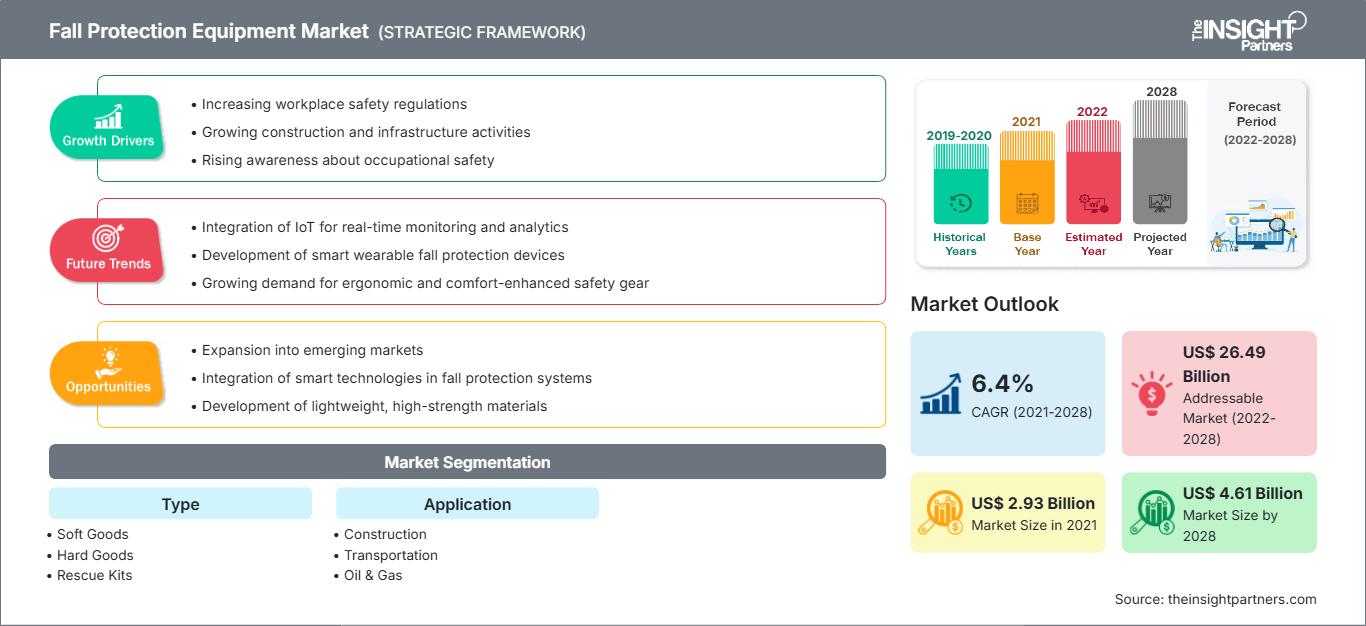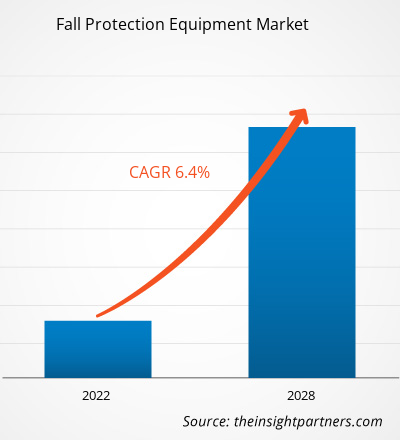Se prevé que el mercado de equipos de protección contra caídas crezca de 2.934,86 millones de dólares estadounidenses en 2021 a 4.606,61 millones de dólares estadounidenses en 2028; se estima que crecerá a una tasa de crecimiento anual compuesta (TCAC) del 6,4% durante el período 2021-2028.
La rápida industrialización en los países desarrollados y en desarrollo es uno de los principales factores que impulsan la expansión del mercado. Los riesgos laborales son cada vez más frecuentes debido a la falta de procedimientos de seguridad adecuados en diversas plantas de fabricación, minas y otros centros industriales. En comparación con otros países, Estados Unidos se preocupa más por la seguridad y la salud de sus trabajadores, lo que impulsa la adopción de equipos de protección contra caídas en el país. Para supervisar las normas y los procedimientos de seguridad, el país ha establecido organismos como la Administración de Seguridad y Salud Ocupacional (OSHA) y el Instituto Nacional Estadounidense de Estándares (ANSI). La OSHA es una organización que regula y cumple las normas de salud y seguridad, y ofrece a los trabajadores capacitación de 10 y 30 horas sobre las normas y reglamentos de la OSHA relevantes para diversas ocupaciones en el lugar de trabajo. Sin embargo, el creciente enfoque en las prácticas de seguridad en el trabajo y la mejora de las regulaciones gubernamentales para la seguridad de los trabajadores en Europa y Asia han impulsado el mercado. Se espera que el aumento de la actividad de la construcción y el creciente sector del petróleo y el gas en países asiáticos como India y China, debido al aumento de la población, impulsen el crecimiento del mercado durante el período de pronóstico. El aumento de la urbanización y el crecimiento de la industria del petróleo y el gas se encuentran entre los factores clave que respaldan el crecimiento del mercado de equipos de protección contra caídas en las regiones de Oriente Medio y África (MEA) y Sudamérica (SAM).
Obtendrá personalización gratuita de cualquier informe, incluyendo partes de este informe, análisis a nivel de país y paquetes de datos de Excel. Además, podrá aprovechar excelentes ofertas y descuentos para empresas emergentes y universidades.
Mercado de equipos de protección contra caídas: Perspectivas estratégicas

-
Obtenga las principales tendencias clave del mercado que se describen en este informe.Esta muestra GRATUITA incluirá análisis de datos, que abarcarán desde tendencias de mercado hasta estimaciones y pronósticos.
Impacto de la pandemia de COVID-19 en el mercado de equipos de protección contra caídas
El brote de COVID-19 continuó teniendo efectos adversos en varios países durante 2021. El cierre de plantas de producción, la limitación de operaciones comerciales, los confinamientos y las restricciones de viaje afectaron la producción y la cadena de suministro de equipos de protección contra caídas. La demanda constante de estos equipos experimentó un ligero descenso en 2020 debido al confinamiento impuesto por el gobierno y a la baja cantidad de proyectos de construcción. Sin embargo, en 2021, debido al aumento de la actividad en la construcción, la exploración de petróleo y gas, y los proyectos de telecomunicaciones, existe una demanda de equipos de protección contra caídas para garantizar la seguridad de los empleados. El comercio electrónico también contribuyó a incrementar la necesidad de estos equipos en el sector de la construcción.
Perspectivas del mercado de equipos de protección contra caídas
Aumento de las actividades de construcción
El auge de la actividad constructiva a nivel mundial es un factor clave que impulsa el mercado de equipos de protección contra caídas. Dado el significativo crecimiento demográfico que experimentan países asiáticos como India y China, la demanda de espacios comerciales y residenciales en estos países se expande constantemente. La economía global atraviesa actualmente una grave desaceleración debido a una creciente restricción crediticia que impide a las economías de todo el mundo alcanzar sus objetivos de desarrollo. La infraestructura sigue siendo una prioridad fundamental para superar las brechas de desarrollo en el contexto actual, ya que se la considera esencial para sacar a las economías de la crisis financiera. Los gobiernos de todo el mundo invierten fuertemente en infraestructura física y social para impulsar la demanda de productos y servicios mediante la creación de empleo.
Información de mercado basada en tipos
Según su tipo, el mercado de equipos de protección contra caídas se segmenta en productos blandos, productos rígidos, kits de rescate, cinturones de seguridad, arneses de cuerpo completo y otros. El segmento de productos rígidos lidera el mercado, ya que ofrece mayor seguridad. Además, se prevé que la creciente innovación en este segmento impulse el crecimiento del mercado. Sin embargo, la creciente demanda de sistemas de arnés de cuerpo completo por parte de todos los usuarios industriales está contribuyendo a que este segmento crezca a la mayor tasa de crecimiento anual compuesto (TCAC).
Información de mercado basada en aplicaciones
En cuanto a su aplicación, el mercado de equipos de protección contra caídas se divide en construcción, petróleo y gas, transporte, energía y servicios públicos, y telecomunicaciones. Para garantizar el buen desarrollo de las actividades y la seguridad de los trabajadores, cada sector requiere equipos de protección contra caídas en sus instalaciones. En 2020, el segmento de la construcción representó la mayor cuota de mercado.
Las empresas que operan en el mercado de equipos de protección contra caídas adoptan estrategias como fusiones, adquisiciones e iniciativas de mercado para mantener su posición. A continuación, se enumeran algunos avances de las principales empresas:
- En mayo de 2021, Pure Safety Group integró sus marcas de seguridad para trabajos en altura —Stronghold by PSG, Ty-Flt, Checkmate y HART— bajo la marca Guardian. Esta expansión ha convertido a Guardian en la marca independiente líder mundial en protección y prevención de caídas.
- 3M Fall Protection inventó e incluyó correas de seguridad contra traumatismos por suspensión en todos los arneses 3M DBI SALA certificados por ANSI y CSA a finales de marzo de 2021.
Perspectivas regionales del mercado de equipos de protección contra caídas
Los analistas de The Insight Partners han explicado en detalle las tendencias regionales y los factores que influyen en el mercado de equipos de protección contra caídas durante el período de previsión. Esta sección también analiza los segmentos y la geografía del mercado de equipos de protección contra caídas en Norteamérica, Europa, Asia Pacífico, Oriente Medio y África, y Sudamérica y Centroamérica.
Alcance del informe de mercado de equipos de protección contra caídas
| Atributo del informe | Detalles |
|---|---|
| Tamaño del mercado en 2021 | 2.930 millones de dólares estadounidenses |
| Tamaño del mercado para 2028 | 4.610 millones de dólares estadounidenses |
| Tasa de crecimiento anual compuesto global (2021 - 2028) | 6,4% |
| Datos históricos | 2019-2020 |
| período de previsión | 2022-2028 |
| Segmentos cubiertos |
Por tipo
|
| Regiones y países cubiertos |
América del norte
|
| Líderes del mercado y perfiles de empresas clave |
|
Densidad de los actores del mercado de equipos de protección contra caídas: comprensión de su impacto en la dinámica empresarial.
El mercado de equipos de protección contra caídas está creciendo rápidamente, impulsado por la creciente demanda de los usuarios finales debido a factores como la evolución de las preferencias de los consumidores, los avances tecnológicos y una mayor conciencia de los beneficios del producto. A medida que aumenta la demanda, las empresas amplían su oferta, innovan para satisfacer las necesidades de los consumidores y aprovechan las nuevas tendencias, lo que impulsa aún más el crecimiento del mercado.

- Obtenga una visión general de los principales actores del mercado de equipos de protección contra caídas.
El mercado mundial de equipos de protección contra caídas se ha segmentado como se indica a continuación:
Por tipo
- Artículos textiles
- Bienes duraderos
- Kits de rescate
- Cinturones corporales
- Arnés de cuerpo completo
- Otros
Mediante solicitud
- Construcción
- Transporte
- Petróleo y gas
- Minería
- Energía y servicios públicos
- Telecomunicaciones
- Otros
Por geografía
-
América del norte
- A NOSOTROS
- Canadá
- México
-
Europa
- Francia
- Alemania
- Italia
- Reino Unido
- Rusia
- El resto de Europa
-
Asia Pacífico (APAC)
- Porcelana
- India
- Corea del Sur
- Japón
- Australia
- Resto de Asia Pacífico
-
Oriente Medio y África (MEA)
- Sudáfrica
- Arabia Saudita
- Emiratos Árabes Unidos
- Resto de Oriente Medio y África
-
Sudamérica (SAM)
- Brasil
- Argentina
- El resto de SAM
Perfiles de empresas
- 3M
- Falltech
- Producción de French Creek
- Primera línea
- Protección contra caídas Guardian
- Mantén la seguridad
- KwikSafety
- MSA Safety Incorporated
- Honeywell International Inc.
- Protección contra caídas Tritech
- Análisis histórico (2 años), año base, pronóstico (7 años) con CAGR
- Análisis PEST y FODA
- Tamaño del mercado, valor/volumen: global, regional y nacional
- Industria y panorama competitivo
- Conjunto de datos de Excel
Informes recientes
Testimonios
Razón para comprar
- Toma de decisiones informada
- Comprensión de la dinámica del mercado
- Análisis competitivo
- Información sobre clientes
- Pronósticos del mercado
- Mitigación de riesgos
- Planificación estratégica
- Justificación de la inversión
- Identificación de mercados emergentes
- Mejora de las estrategias de marketing
- Impulso de la eficiencia operativa
- Alineación con las tendencias regulatorias






















 Obtenga una muestra gratuita para - Mercado de equipos de protección contra caídas
Obtenga una muestra gratuita para - Mercado de equipos de protección contra caídas